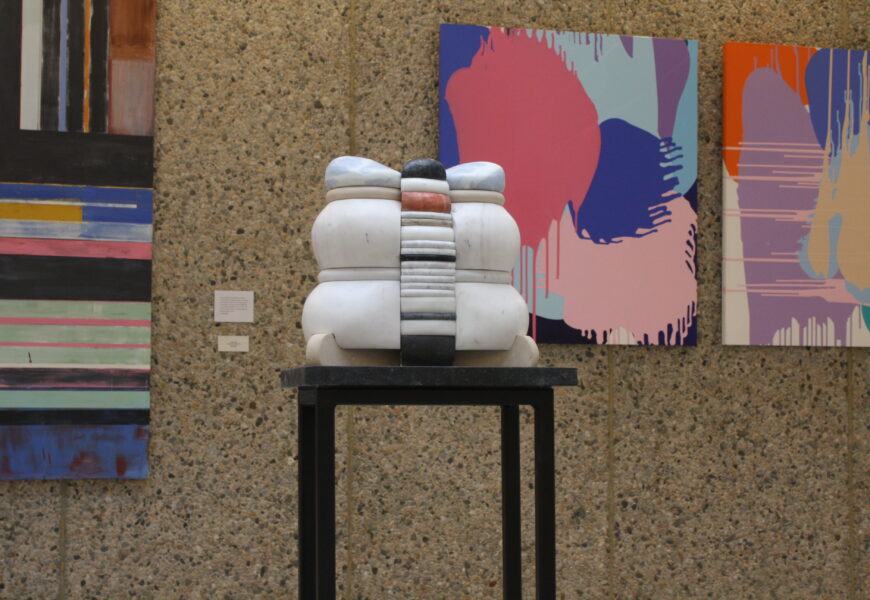Courtesy of Amelia Racicot ’27
Located on the first floor of Cummings, Don Porcaro’s art gallery Everybody Knows speaks to the dual-identity of many Italian-Americans, and the recognition of one’s Italian heritage through the medium of marble — a material of great historical and cultural significance in Italy.
Porcaro illustrated it best in his artist’s statement, a description of visiting Connecticut, seeing the rolling stone yards of monuments and gravestones, and nostalgic early childhood memories with family as a calling to his roots. “From the first time I cut a piece of stone, I knew that it felt right. It fed a need to work with a material that speaks to tradition, and I knew that that tradition belonged to my culture,” said Porcaro.
“With its mix of narrative and abstract painting, installation, textile, and sculpture, A Legacy of Making: 26 Contemporary Artists Inspired by Their Italian Heritage brings an entire famiglia to the table, each with different ideas and ways of expressing them,” wrote curator Joanne Mattera in her statement on Cumming’s latest art exhibit. “Drawing from all of Italian culture and tradition, we continue the legacy in our studios, reinventing it as American art.”
“We all have something in our genes, in our DNA, that has come from our ancestors,” reflected Professor Tim McDowell, who served as a curatorial aid. “If they’ve proven scientifically that trauma can be passed on to generations, why can’t creativity, ingenuity, music, [and] art be too?”
The exhibit is based on Mattera’s book, Italianita: Contemporary Art Inspired by the Italian Immigrant Experience. Published last year, her book explores the art of 60 Italian artists and the cultural aspects that connect them all, despite the inspection of a variety of artistic mediums, styles, and artists coming from a range of backgrounds. Her book, exhibition, and larger goals to shed light on the immigrant experience stem from her cultural connections to Italy and America, and more specifically the politics in both countries regarding immigration.
“We have to stand up for immigrants. They come with the least amount of money and the least amount of power, and they’re working hard to create a new life. That started me thinking about the great gifts that I had received from my own immigrant family,” said Mattera. “I grew up in that culture of many languages, of wonderful food, of kind people, and I knew a number of Italian American artists who are Italian American. I asked them how they felt their culture informed them personally as well as their art, and they all responded.”
McDowell added to this by citing the great influx of immigrants to Italy in recent years and Italian immigrants to America in the past few centuries, as well as the xenophobia that both countries exert against immigrants. “This show is important because of the crisis right now politically, with a lot being said not in favor of immigration and immigrants, demeaning them,” he said.
“This is kind of a slap in the face of that political attitude, saying, ‘Well, look, you know, we’re creative. We’ve built things here. We’ve benefited the place.’ And every culture can say that… this is what made this country,” he boldly proclaimed.
The exhibit began in New York City at the Calandra institute, and was brought over from the smaller venue in Manhattan to Cumming’s Art center in Connecticut, where Mattera was able to expand the showing due to the new larger space. Its opening reception was on September 14, and it will continue to be open for viewing until October 19.
“You really get a broader sense of the idea of italianita, of how one sense of Italian-ness, and how that gets translated into artwork. The space is fantastic,” he continued.
Another eye-catching sculpture is hung on the first floor, a warped interpretation of baroque architecture and Italian Roman Catholic imagery, and symbolism deconstructed into a black, melded form dusted with the slightest touch of gold shimmer. John Monti’s Black Frost serves as a reclamation and reconstruction of one’s unique culture, taking traditions and adapting them to one’s individual identity. “I was proud of my parents’ story and the Italian culture we were part of, but that was really ‘their’ story. I wondered: What was mine?” said Monti. “I eventually found my story through art.”
Though the nearby abstract oil painting Large Carbon Riff may present as an exploration of the technical aspects of art like line, color, shape and texture, artist Lloyd Martin expresses his role as an artist and his work’ connections to his heritage, his pieces serving as a testament to his family and culture. “I wouldn’t have applied to art school or college if it were not for Filomena… The example of hard work and the support that my family demonstrated is the only reason I am still at it, working toward an imagined ideal that still seems within reach.”
“Everyone’s story was interesting, slightly different, and yet there was a thread that ran through all of them,” said Mattera.









